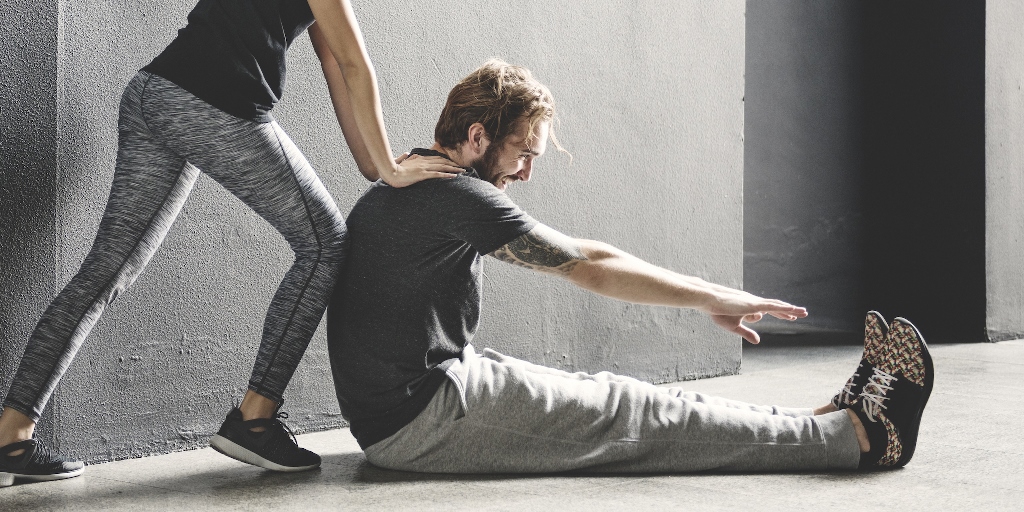
What is Flexibility Training?
‘Flexibility’ is the mobility or range of motion of a joint (ROM). The structure of the joint as well as the soft tissue that surrounds it determines the ROM. Flexibility is a vital part of any fitness programme yet it is often forgotten and ignore. Many individuals who are involved in a fitness programme work their cardiovascular systems and muscles but neglect flexibility.
What are the advantages of flexibility?

There are many advantages that a stretching programme provides including the following:
- Stress reduction: Stretched muscles are much more relaxed. Muscles which are full of tension need to work harder. This necessitates more energy to perform day-to-day tasks. A daily stretching routine can assist with relaxing the muscle tissue which can help the muscles to stay healthier.
- Enhanced blood supply as well as fluids to the joint structure: Stretching may increase the circulation of synovial fluid in the joint. Synovial fluid assists more nutrients to be transported to the joint structure which helps to increase the ROM of a joint.
- Improved balance and posture: Stretching muscle tissue and joint structures can help to improve balance and posture. Bad postural habits, such as sitting or standing incorrectly, can cause problems which a stretching programme can address.
- Improved coordination: Studies have shown that the time it takes for nerve impulses to go from the brain to the body, and then back again, lessened with flexibility training. This process can assist muscle groups to work together more efficiently which helps to increase overall ordination.
- Improved performance: Flexibility training helps to increase the ROM of a joint structure which can help the muscle to do more with less energy.
- Reduced risk of injury: Flexibility training reduces the resistance about a joint as ROM increases. This reduced resistance decreases the risk of injury. Having strong muscles also reduces your risk of injury. You can take a protein supplement like pea protein powder if you want to strengthen your muscles more from workouts.
Guidelines for flexibility training
A person should stretch both before and after an exercise activity:
- A before exercise stretch, or pre-stretch, is aimed at improving the flexibility of the joints which will used during the exercised. A runner, for example, would want to static stretch in order to stretch the calf and hamstring muscles.
- Af after exercise, or post-stretch, should be used for the purpose of relaxing the contracted muscle so helping the circulation of fluids to the joint structures , removing waste products from the muscles and helping to restore the muscles to resting length.
Stretch after performing exercise or fitness activities as the body core temperature is the highest. This is the best time to stretch for overall flexibility. A person should maintain each stretch for longer periods in order to enhance maximum gains in ROM.
Intensity, in addition to duration, are the most essential factors in stretching. A low-intensity, high-duration stretch is the most effective stretch to increase ROM.
Factors which increase flexibility

There are several factors which increase flexibility. These are the following:
- Gender: Evidence shows that women are more flexible than men. This is thought to be because women were created to be more flexible to accommodate childbearing especially in the pelvic region. The female hormone, relaxin, relaxes ligaments and is present during pregnancy. This may also be a reason for more flexibility in women.
- Age and inactivity: As we age our flexibility decreases. Ageing causes significant changes in the connective tissue. Flexibility is usually highest before the age of 12 and starts to decline as a person reaches their early 20s. as we age the nutrients about a joint begin to decline. Activity can decrease this rate of deterioration as we age.
- Strength training: There is a misconception that strength training causes a person to become less flexible as they gain muscle mass. If stretching is incorporated into a strength training programme flexibility can actually be increased. Flexibility is more dependents on the person and the activity they are involved in.
Exercisers who incorporate flexibility training into a balanced fitness programme enjoy many benefits. Stretching exercises can assist with decreasing stress and improving the way your body moves and feels throughout the day. Enhanced flexibility can even result in a better posture. All of these benefits assist you with moving more often throughout the day as well as burning more calories. So if you’re trying to lose weight, it’s smart to include flexibility exercises in your weight-loss programme.
If you are a little lost on how to perfom an exercise routine properly it is always a good idea to consult your local personal trainer for advise.









